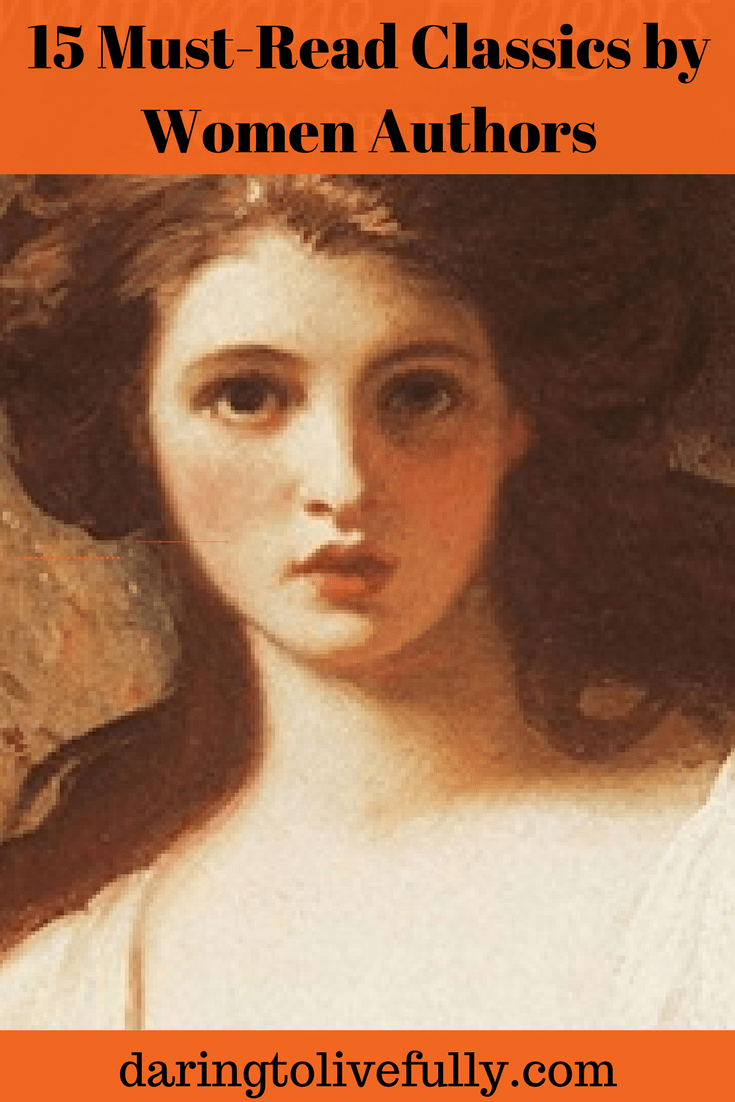
Women have made invaluable contributions to literature.
Historically, the talent of women authors has not been recognized. As an illustration of this, a while ago I wrote about the Harvard Classics–a famous anthology of classic books from world literature compiled and edited by Harvard University president Charles W. Eliot. When it was first published in 1909, no female writers were included in the anthology.
 Today is the 8th of March–International Women’s Day. It’s a global day for celebrating the contributions that women have made to society. In recognition of International Women’s Day, I wanted to share with you what I consider to be 15 must-read classics by women authors. You’ll find the list below.
Today is the 8th of March–International Women’s Day. It’s a global day for celebrating the contributions that women have made to society. In recognition of International Women’s Day, I wanted to share with you what I consider to be 15 must-read classics by women authors. You’ll find the list below.
1. Pride and Prejudice by Jane Austen (1813). Novel – England.
From the synopsis on the book’s back cover:
“When Elizabeth Bennet first meets eligible bachelor Fitzwilliam Darcy, she thinks him arrogant and conceited; he is indifferent to her good looks and lively mind. When she later discovers that Darcy has involved himself in the troubled relationship between his friend Bingley and her beloved sister Jane, she is determined to dislike him more than ever. In the comedy of manners that follows, Jane Austen shows the folly of judging by first impressions and evokes the friendships, gossip and snobberies of provincial middle-class life.”
2. Frankenstein by Mary Shelley (1818). Novel – England.
From the synopsis on the book’s back cover:
“Few creatures of horror have seized readers’ imaginations and held them for so long as the anguished monster of Mary Shelley’s Frankenstein. The story of Victor Frankenstein’s terrible creation and the havoc it caused has enthralled generations of readers and inspired countless writers of horror and suspense.”
3. Wuthering Heights by Emily Brontë (1847). Novel – England.
From the synopsis on the book’s back cover:
“Wuthering Heights is a wild, passionate story of the intense and almost demonic love between Catherine Earnshaw and Heathcliff, a foundling adopted by Catherine’s father. After Mr Earnshaw’s death, Heathcliff is bullied and humiliated by Catherine’s brother Hindley and wrongly believing that his love for Catherine is not reciprocated, leaves Wuthering Heights, only to return years later as a wealthy and polished man. He proceeds to exact a terrible revenge for his former miseries.
4. Jane Eyre by Charlotte Brontë (1847). Novel – England.
From the synopsis on the book’s back cover:
“Jane Eyre ranks as one of the greatest and most perennially popular works of English fiction. Although the poor but plucky heroine is outwardly of plain appearance, she possesses an indomitable spirit, a sharp wit and great courage.
She is forced to battle against the exigencies of a cruel guardian, a harsh employer and a rigid social order. All of which circumscribe her life and position when she becomes governess to the daughter of the mysterious, sardonic and attractive Mr Rochester.
However, there is great kindness and warmth in this epic love story, which is set against the magnificent backdrop of the Yorkshire moors.”
5. Agnes Grey by Anne Brontë (1847). Novel – England.
From the synopsis on the book’s back cover:
“This novel is a trenchant expose of the frequently isolated, intellectually stagnant and emotionally-starved conditions under which many governesses worked in the mid-19th century. This is a deeply personal novel written from the author’s own experience and as such Agnes Grey has a power and poignancy which mark it out as a landmark work of literature dealing with the social and moral evolution of English society during the last century.”
6. Sonnets from the Portuguese: A Celebration of Love by Elizabeth Barrett Browning (1850). Poetry – England.
From the synopsis on the book’s back cover:
“Written for her husband, Robert Browning, who had affectionately nicknamed her his “little Portuguese,” the sequence is a celebration of marriage, and of one of the most famous romances of the nineteenth century. Recognized for their Victorian tradition and discipline, these are some of the most passionate and memorable love poems in the English language. There are forty-four poems in the collection, including the very beautiful sonnet, ‘How do I love thee? Let me count the ways.'”
7. Uncle Tom’s Cabin by Harriet Beecher Stowe (1852). Novel – American.
From the synopsis on the book’s back cover:
“Stowe’s powerful abolitionist novel fueled the fire of the human rights debate in 1852. Denouncing the institution of slavery in dramatic terms, the incendiary novel quickly draws the reader into the world of slaves and their masters.”
8. Middlemarch by George Eliot (1871). Novel – England.
From the synopsis on the book’s back cover:
“Middlemarch is a complex tale of idealism, disillusion, profligacy, loyalty and frustrated love. This penetrating analysis of the life of an English provincial town during the time of social unrest prior to the Reform Bill of 1832 is told through the lives of Dorothea Brooke and Dr Tertius Lydgate and includes a host of other paradigm characters who illuminate the condition of English life in the mid-nineteenth century.”
9. The Complete Poems of Emily Dickinson by Emily Dickenson (1890). Poetry – American.
From the synopsis on the book’s back cover:
“Though generally overlooked during her lifetime, Emily Dickinson’s poetry has achieved acclaim due to her experiments in prosody, her tragic vision and the range of her emotional and intellectual explorations.”
10. The Age of Innocence by Edith Wharton (1920). Novel – American.
From the synopsis on the book’s back cover:
“At the heart of the story are three people whose entangled lives are deeply affected by the tyrannical and rigid requirements of high society. Newland Archer, a restrained young attorney, is engaged to the lovely May Welland but falls in love with May’s beautiful and unconventional cousin, Countess Ellen Olenska. Despite his fear of a dull marriage to May, Archer goes through with the ceremony — persuaded by his own sense of honor, family, and societal pressures.”
11. Mrs. Dalloway by Virginia Wolf (1925). Novel – English.
From the synopsis on the book’s back cover:
“In this vivid portrait of one day in a woman’s life, Clarissa Dalloway is preoccupied with the last-minute details of a party she is to give that evening. As she readies her house she is flooded with memories and re-examines the choices she has made over the course of her life.”
12. A Good Man Is Hard to Find and Other Stories by Flannery O’Connor (1955). Short Stories – American.
From the synopsis on the book’s back cover:
“Steeped in a Southern Gothic tradition that would become synonymous with her name, these stories show O’Connor’s unique, grotesque view of life– infused with religious symbolism, haunted by apocalyptic possibility, sustained by the tragic comedy of human behavior, confronted by the necessity of salvation.”
13. Collected Poems by Edna St. Vincent Millay (1956). Poetry – American.
From the synopsis on the book’s back cover:
“Alongside Robert Frost, T.S. Eliot, Marianne Moore, and E. E. Cummings, Millay remains among the most celebrated poets of the early twentieth century for her uniquely lyrical explorations of love, individuality, and artistic expression.”
14. Atlas Shrugged by Ayn Rand (1957). Novel – American.
From the synopsis on the book’s back cover:
“With this acclaimed work and its immortal query ‘Who is John Gait?’, Ayn Rand found the perfect artistic form to express her vision of existence. This is the book that made her not only one of the most popular novelists of our century, but also one of its most influential thinkers.”
15. To Kill a Mockingbird by Harper Lee (1960). Novel – American.
From the synopsis on the book’s back cover:
“The unforgettable novel of a childhood in a sleepy Southern town and the crisis of conscience that rocked it. . . Compassionate, dramatic, and deeply moving, To Kill A Mockingbird takes readers to the roots of human behavior – to innocence and experience, kindness and cruelty, love and hatred, humor and pathos.”
Honorable Mentions
Here are four classics by women that didn’t make it into the top 15, but that nonetheless deserve an honorable mention:
- North and South by Elizabeth Gaskell
- Anne of Green Gables by Lucy Maud Montgomery
- Little Women by Louisa May Alcott
- The Awakening by Kate Chopin
Conclusion
How many of the classics above have you read? I’ve read several of them, but I still have work to do. In addition, which books did I leave out which you think should have been included?
Live your best life by reading these must-read classics by women authors.





Related Posts:




 Marelisa Fabrega is a lawyer and entrepreneur. She holds a Bachelor of Science in Business Administration from Georgetown University in Washington, D.C., as well as a Juris Doctor from the Georgetown University Law Center. You can learn more about her
Marelisa Fabrega is a lawyer and entrepreneur. She holds a Bachelor of Science in Business Administration from Georgetown University in Washington, D.C., as well as a Juris Doctor from the Georgetown University Law Center. You can learn more about her 





